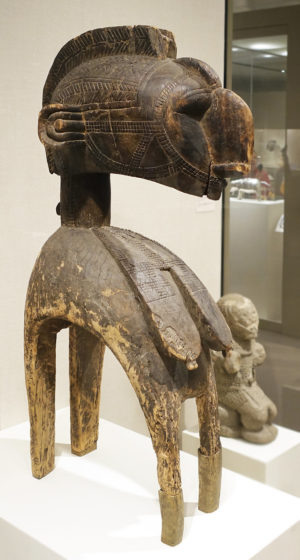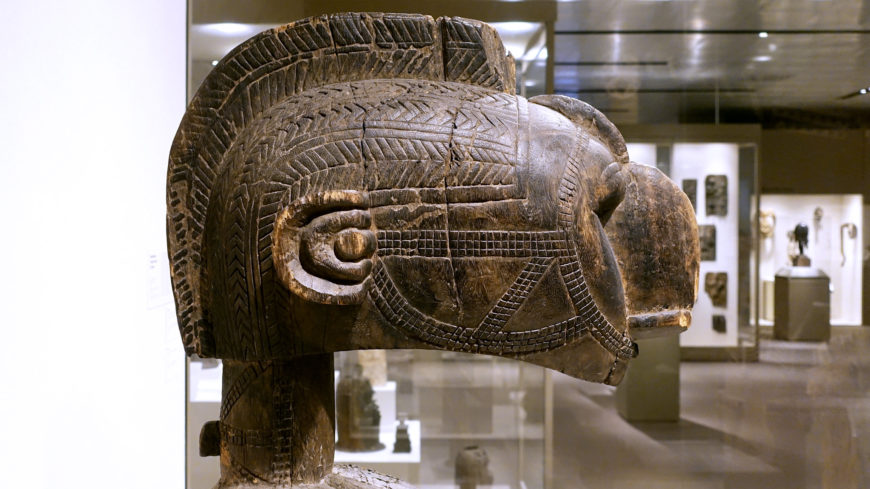D’mba mask (Baga peoples, Guinea), 19th–20th century, wood, 118.1 x 35.3 x 67.5 cm (The Metropolitan Museum of Art) Speakers: Dr. Peri Klemm and Dr. Beth Harris

Headdress: Female Bust (D’mba), 19th–20th century, Guinea, Niger River region, Baga peoples, wood, 181.1 x 35.3 x 67.5 cm (The Metropolitan Museum of Art; photo: Steven Zucker, CC BY-NC-SA 2.0)
This massive headdress is an example of a regional artistic tradition that dates to at least 1886 and possibly to the early seventeenth century. Among Baga subgroups the headdress is referred to variously as D’mba or Yamban, an abstract concept personifying local ideals of female power, goodness, and social comportment.
Carved from a single piece of wood, this work takes the form of a large head and slender neck supported by a yoke with four projecting legs. Flat, pendulous breasts signify that the subject is a mature woman who has nursed many children. She is distinguished from ordinary Baga by her intricately braided coiffure with high central crest, a hairstyle associated with Fulbe women, who are renowned for their physical beauty. This coiffure is also a reminder of cultural origins, as the Fulbe live in the Futa Jallon mountains, the ancestral homeland of the Baga people.
Incised linear patterns representing scarification marks decorate her face, neck, and breasts. Such monumental structures, carried on the shoulders of the performer, often weigh more than eighty pounds. In its original context, the headdress would have had a thick raffia skirt attached to the bottom of the yoke. A shawl of dark cotton cloth, imported from Europe, would be tied around the shoulders, hiding the legs of the yoke.
The ideals of womanhood expressed symbolically by the strong forms of the headdress are reinforced by the movement of the male dancer, who communicates a model of virtuous behavior for Baga women. Performances documented in the 1990s describe the dramatic entrance of the masquerader in a central plaza, preceded by a processional line of drummers. Despite its unwieldy size, the headdress is manipulated skillfully by the dancer, whose movements are alternately composed and vigorous. As the dancer twirls to the accompaniment of drums, the assembled audience of male and female onlookers participates actively. Some reach to touch the breasts of the headdress, affirming its blessings of fertility, while others throw rice, symbolizing agricultural bounty. Songs prescribing proper social behavior are led by women who are joined in the chorus by men. Beginning at sunrise, the celebration continues through sundown and sometimes over the course of many days.

Detail, Headdress: Female Bust (D’mba), 19th–20th century, Guinea, Niger River region, Baga peoples, wood, 181.1 x 35.3 x 67.5 cm (The Metropolitan Museum of Art; photo: Steven Zucker, CC BY-NC-SA 2.0)
Historically, such masks were used in dances held at planting times and harvest celebrations, as well as at marriages, funerals, and ceremonies in honor of special guests. Following Guinea’s independence from France in 1958 and its adoption of a Marxist government, the tradition was suppressed by Muslim leaders and state officials. In the 1990s, the lifting of decades of censorship was followed by a popular revival of earlier art forms. In Baga society, D’mba (or Yamban) now appears publicly on occasions marking personal and communal growth, including marriages, births, and harvest festivals, as well as celebratory occasions such as soccer tournaments.
© 2006 The Metropolitan Museum of Art, New York (by permission)
Additional resources
This work at The Metropolitan Museum of Art.
Baga peoples from Art and Life in Africa (University of Iowa).
Smarthistory images for teaching and learning:
[flickr_tags user_id=”82032880@N00″ tags=”Dmba,”]
[0:00] [music]
Dr. Peri Klemm: [0:05] We’re at the Metropolitan Museum of Art, and we’re looking at a mask called a D’mba mask. It’s made by the Baga people in Guinea.
Dr. Beth Harris: [0:14] When you think about a mask, we tend to think about something that goes on the face, or even in African tradition, something that’s worn around the head, like a helmet mask. We have four legs, so to speak. The head of the wearer would have gone in there, surrounded by fabric and raffia underneath, but it doesn’t read to me as a mask, it reads as a sculpture.
Dr. Klemm: [0:37] It would have sat on the masker’s shoulders and on the top of his head. It weighs about 80 pounds, so it was very difficult to maneuver.
Dr. Harris: [0:44] Clearly a female form, her breasts are very prominent, but worn by a man and the carver would have also been a man.
Dr. Klemm: [0:51] Carving, mask-making, and the wearing of masks is really the domain of men in West Africa. While it’s female in form, it has a female-crested hairstyle and the pendulous breasts, it would’ve been danced by a male masquerader.
Dr. Harris: [1:04] It’s so monumental that you immediately get a sense of the power of the idea that this sculpture represents.
Dr. Klemm: [1:11] In many masquerading traditions in West Africa, masks are either the personification of a spirit, whether it is the spirit of an ancestor, or the spirit of a forest.
Dr. Harris: [1:21] Or the spirit of an animal.
Dr. Klemm: [1:23] But in this case, it’s none of those things. It’s said to be a personification of beauty, of goodness, of a woman at her zenith, in terms of her power and her potential.
Dr. Harris: [1:34] Unlike other sculptures that we see in African art where a female figure is shown with breasts that are very high, at the prime of life in adolescence, here we have a woman depicted as powerful later in life, after she’s born and nursed and raised many children.
Dr. Klemm: [1:52] Her breasts are flat, downturned, and it suggests that she is no longer able to nurse. Rather, her children are grown, they’re healthy, and she has now entered into an important time in her life where she can inspire others.
Dr. Harris: [2:04] And must have garnered enormous respect from the community.
Dr. Klemm: [2:09] It was danced as a way to inspire young men and young women who were going to become parents.
Dr. Harris: [2:15] The audience would sometimes go up and touch her breasts.
Dr. Klemm: [2:19] While the D’mba mask was worn, historically, during times of harvest and planting as well as life cycle rituals, with the introduction of the Marxist regime after the fall of the colonial government in Guinea, masquerades such as this weren’t performed anymore.
[2:33] But since the 1990s, there’s been a renewed interest in bringing them back, and so we find them again at festivals, like marriage, like birth, where women’s fertility is really celebrated.
Dr. Harris: [2:44] We have three parts: this body with the breasts, the neck, and this enormous head. We see decorative patterning on her face, scarification. We see a hairstyle that’s also very specific.
Dr. Klemm: [2:57] For women, it’s meant to help give them the strength to go through childbirth, and then the years and years of caring for that child until they make it to puberty.
[3:05] For young men, it’s thought to inspire them to provide for women as they go through this very difficult process. In a sense, while it’s a female depiction, it’s intended to help the entire community successfully support motherhood.
Dr. Harris: [3:20] What’s so wonderful to me in that light is that there’s this acknowledgement of the difficulty of not only childbirth but also motherhood.
Dr. Klemm: [3:30] She seems massive and clunky. She’s not dainty with refined features. This is power realized, and in that sense, she is beautiful. It’s intended to show the strength of women.
Dr. Harris: [3:40] The strength of older women, because even though it is so abstract there is a sense of her age here, not just in her breasts but even in those abstracted facial features.
Dr. Klemm: [3:50] That maturity is also conveyed with her gaze. She looks very wise.
Dr. Harris: [3:54] A stable force for the community.
[3:57] [music]

